
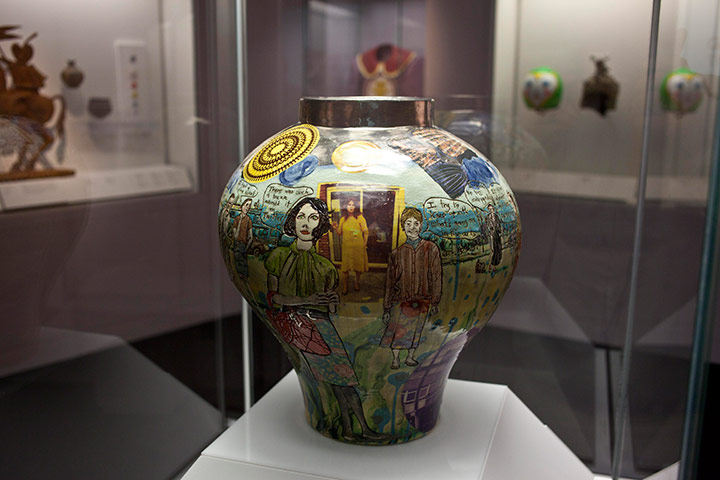
Perry je dobitnik Turnerove nagrade pa je priznat tip, a njegova "engleska" ekscentričnost dobro dođe (Englezi na svoju sramotu imaju kraljicu ali umjetnicima u njihovom zoološkom vrtu dopuštaju sve - skužili su da je to dobro za izvoz - samo ih ne vole u svome susjedstvu): premda je transvestit (djevojčica Claire njegov je ženski alter ego) Perry je istovremeno i neki njihov "akademik" (Royal Academician). Njegov trik: dekorativne medije (keramiku, tapiserije) pretvoriti u nešto "subverzivno" (danas si, kažu, subverzivan kad istražuješ teme sadomazohizma, rodnog identiteta i sl.)
Grayson Perry
British ceramist, visual artist & writer
 Grayson Perry was born in Chelmsford in 1960. He studied at Braintree College of Further Education and at Portsmouth Polytechnic. His numerous solo exhibitions since the early 1980s include James Birch Gallery, London (1984), Birch & Conran Gallery, London (1987), Fig 1, London (2000) and the recent major solo presentation of his work, Guerrilla Tactics, at the Stedelijk Museum, Amsterdam and the Barbican Art Gallery, London (2002). He has participated in many group exhibitions including Young Contemporaries (1981-2), Objects of our Time, Crafts Council touring exhibition (1997-8), Over the Top, Ikon Gallery, Birmingham (1999), The British Art Show 5, touring exhibition (2000), Protest and Survive, Whitechapel Art Gallery, London (2000), New Labour, Saatchi Gallery, London (2001).
Grayson Perry was born in Chelmsford in 1960. He studied at Braintree College of Further Education and at Portsmouth Polytechnic. His numerous solo exhibitions since the early 1980s include James Birch Gallery, London (1984), Birch & Conran Gallery, London (1987), Fig 1, London (2000) and the recent major solo presentation of his work, Guerrilla Tactics, at the Stedelijk Museum, Amsterdam and the Barbican Art Gallery, London (2002). He has participated in many group exhibitions including Young Contemporaries (1981-2), Objects of our Time, Crafts Council touring exhibition (1997-8), Over the Top, Ikon Gallery, Birmingham (1999), The British Art Show 5, touring exhibition (2000), Protest and Survive, Whitechapel Art Gallery, London (2000), New Labour, Saatchi Gallery, London (2001). | Dolls at Dungeness, September, 11th 2001 - Immediately after the attack on the twin towers, the media seemed to be full of reports of prejudice and anger from all sides. In this pot the toys are just as much the bigots and aggressors as the war planes flying overhead, both are inanimate objects on to which we project our feelings. My father helped to build Dungeness Nuclear Power Station. |
In the early 1980s Grayson Perry was a member of the Neo-Naturist group, participating in performance and film works. He has continued to make work in a variety of media which now include embroidery and photography. Yet Perry is best known for his ceramic works, creating classically shaped vases decorated with figures, objects and text, which stand within a tradition stretching back for centuries. The revealing and often dark subject matter depicted on these pots is at first disguised by their colourful, decorative nature. His chosen topics include autobiographical images of himself, his transvestite alter ego Claire, and his family, as well as references to political events and an investigation of observed cultural stereotypes. Over the last five years Perry has also used embroidery and photography to explore these themes, most notably in the photograph Mother of all Battles (1996) which shows Claire holding a gun, and wearing Perry’s first embroidered folk costume. This was followed by Claire’s Coming Out (2000), which Perry staged as a performance to present a richly embroidered childlike dress for Claire, in this instance merging his private female persona with his artwork.


Barbaric Splendour, 2003 - Roadside shrines, post-Diana outpourings of common feelings. Perceived as vulgar by those that regard the taste for elaborate decorative arts of the lower orders as morally inferior.
 Perry looks back to his upbringing in the Essex countryside to find his subject matter as presented on the vase, I was an Angry Working Class Man (2001) which presents the recognizable iconography of motorbikes, pub signs and other images of manhood, topped off with the golden figure of an emasculated Pit Bull Terrier, mascot of the stereotypical Essex Man. He also seeks to engage directly with contemporary issues such as in the vase We've Found the Body of your Child (2000), which deals not only with paedophilia, but with child abuse within the home, or Dolls at Dungeness, September 11th 2001, which depicts seemingly innocent infant figures playing in the bleak landscape, whilst war planes hover overhead. Operating within the tradition of William Hogarth or James Gillray, he also uses his ceramics to satirise other art forms, as in Gimmick, 1996, which lists artists’ trademark methods, such as Jackson Pollock-drips or Alexander Calder-mobiles. Perry employs and simultaneously subverts the craft form of ceramics, revelling in its second class status within world of fine arts, to explore challenging, yet witty and thought provoking themes. Perry comments, ‘A lot of my work has always had a guerrilla tactic, a stealth tactic. I want to make something that lives with the eye as a beautiful piece of art, but on closer inspection, a polemic or an ideology will come out of it’.
Perry looks back to his upbringing in the Essex countryside to find his subject matter as presented on the vase, I was an Angry Working Class Man (2001) which presents the recognizable iconography of motorbikes, pub signs and other images of manhood, topped off with the golden figure of an emasculated Pit Bull Terrier, mascot of the stereotypical Essex Man. He also seeks to engage directly with contemporary issues such as in the vase We've Found the Body of your Child (2000), which deals not only with paedophilia, but with child abuse within the home, or Dolls at Dungeness, September 11th 2001, which depicts seemingly innocent infant figures playing in the bleak landscape, whilst war planes hover overhead. Operating within the tradition of William Hogarth or James Gillray, he also uses his ceramics to satirise other art forms, as in Gimmick, 1996, which lists artists’ trademark methods, such as Jackson Pollock-drips or Alexander Calder-mobiles. Perry employs and simultaneously subverts the craft form of ceramics, revelling in its second class status within world of fine arts, to explore challenging, yet witty and thought provoking themes. Perry comments, ‘A lot of my work has always had a guerrilla tactic, a stealth tactic. I want to make something that lives with the eye as a beautiful piece of art, but on closer inspection, a polemic or an ideology will come out of it’.  Grayson Perry, 43, lives and works in London. He won the 2003 Turner Prize, the first time a potter has participated, let alone won this prestigious UK prize. His comment on winning: "It's about time a transvestite potter won the Turner"! He is represented in the UK by Victoria Miro Gallery.
Grayson Perry, 43, lives and works in London. He won the 2003 Turner Prize, the first time a potter has participated, let alone won this prestigious UK prize. His comment on winning: "It's about time a transvestite potter won the Turner"! He is represented in the UK by Victoria Miro Gallery.The above is a press release from Tate Britain, May 2003. Text and images used by permission of the artist.
Brave New Grayson Perry - Hip Hip!
 Hip hip and cheerio to the Queen and all that - you may think that England is the last bastion of
Hip hip and cheerio to the Queen and all that - you may think that England is the last bastion of  conservative tradition, but not when it comes to the Arts. The US caved long ago to conservative interests in terms of major public funding and awards, but the Turner Prize, awarded each year to a British artist under 50, reminds us that energy, spirit and imagination should be celebrated, even if you don't like it or agree with it. In 2003 the Turner Prize was awarded to Grayson Perry, described by Wikipedia as 'an English artist, known mainly for his ceramic vases and cross-dressing.' I recently heard Grayson Perry on a BBC podcast about traditions and was so struck by his interesting remarks that I had to find out more about him - and discovered a
conservative tradition, but not when it comes to the Arts. The US caved long ago to conservative interests in terms of major public funding and awards, but the Turner Prize, awarded each year to a British artist under 50, reminds us that energy, spirit and imagination should be celebrated, even if you don't like it or agree with it. In 2003 the Turner Prize was awarded to Grayson Perry, described by Wikipedia as 'an English artist, known mainly for his ceramic vases and cross-dressing.' I recently heard Grayson Perry on a BBC podcast about traditions and was so struck by his interesting remarks that I had to find out more about him - and discovered a  whole new world. I can't believe I've missed him until now - he's no shrinking violet. He's flamboyant and outspoken, he's a new member of the
whole new world. I can't believe I've missed him until now - he's no shrinking violet. He's flamboyant and outspoken, he's a new member of the  Royal Academy, and he just had a big show at the British Museum called The Tomb of the Unknown Craftsman. Part of his contribution to the Traditions discussion was a comment about liking to work with mediums that require skill and relate to age-old processes, not only ceramics but lately also tapestry. In his ceramics he sticks with traditional forms such as standing vases reminiscent of Greek amphora; he claims to like lulling people into a feeling of security with forms they think they recognize and with expectations of reassuring patterns - flowers or a simple landscape - and then hitting them over the head with his
Royal Academy, and he just had a big show at the British Museum called The Tomb of the Unknown Craftsman. Part of his contribution to the Traditions discussion was a comment about liking to work with mediums that require skill and relate to age-old processes, not only ceramics but lately also tapestry. In his ceramics he sticks with traditional forms such as standing vases reminiscent of Greek amphora; he claims to like lulling people into a feeling of security with forms they think they recognize and with expectations of reassuring patterns - flowers or a simple landscape - and then hitting them over the head with his  intricately drawn decorations
intricately drawn decorations  full of wit, puns, historical references and social comment. He says he has little use for the post-Duchamp conceptual idea of art - it's art if I say it's art - so goes out of his way to make his life as well as his art an exercise in complicated, elaborate craftsmanship. And he's having a great deal of fun doing it - he seems a bit like Cindy Sherman with a sense of humor. I've always on the lookout for great use of
full of wit, puns, historical references and social comment. He says he has little use for the post-Duchamp conceptual idea of art - it's art if I say it's art - so goes out of his way to make his life as well as his art an exercise in complicated, elaborate craftsmanship. And he's having a great deal of fun doing it - he seems a bit like Cindy Sherman with a sense of humor. I've always on the lookout for great use of  drawing and here's a wonderful example of a good hand, plus mind and heart working together to create a sum much greater than the parts. An instant favorite for me is his Punters in the Snow - a witty homage to Bruegel's elegiac 16th century painting Hunters in the Snow. Seeing his work I was reminded of Shakespeare's line from The Tempest: O brave new world That has such people in't!
drawing and here's a wonderful example of a good hand, plus mind and heart working together to create a sum much greater than the parts. An instant favorite for me is his Punters in the Snow - a witty homage to Bruegel's elegiac 16th century painting Hunters in the Snow. Seeing his work I was reminded of Shakespeare's line from The Tempest: O brave new world That has such people in't!I found visuals and interesting information and about Grayson Perry on several blogs including these:
and a longer article on the Royal Academy website
- artsmarttalk.blogspot.com/
Art News – Grayson Perry Named Royal Academician

Grayson Perry, via Esquire
British artist Grayson Perry has been named a Royal Academician for Printmaking at London’s Royal Academy of Arts, joining artists such as Tracy Emin and David Hockney as recipient of the prestigious title. Perry identifies as a transvestite and is known primarily for his ceramic work.

Grayson Perry, Over the Rainbow (2001), via Saatchi Gallery.
The Royal Academicians are a group of up to eighty artists and architects who have been determined by their status as important contributors to British art. According to the Royal Academy’s website, “all RAs are artists by profession and fall into one of the following categories of Membership: Painters (including Engravers, Printmakers and Draughtsmen), Sculptors, Architects. All must be professionally active, either wholly or partly, in the United Kingdom. Of the 80 RAs, there must always be at least 14 Sculptors, 12 Architects and 8 Printmakers with the balance being drawn from the Painters category.” Each RA is entitled to show up to 6 works in the Royal Academy’s famous Summer Show, and is permitted to use the Royal Academy to exhibit his or her work. The Royal Academy is located in Picadilly, London, and is a privately funded institution that has been led by artists and architects since its founding in 1768 through a donation by King George III.

Grayson Perry, Quotes from the Internet (2005), via artnet.
Using traditional ceramic technique as well as collage and decoupage, Perry’s best-known work deals with issues such as sadomasochism, gender roles and identity politics. The work’s originality lies in the dichotomy between the use of a medium generally associated with craft or decoration and the consistently provocative nature of the themes addressed, which are carried over in his work in other media, including tapestries and prints. Upon winning the Turner Prize in 2003 for his vases, Perry appeared at the ceremony as his alter-ego, “Claire,” whom he describes as “a forty-something woman living in a Barratt home, the kind of woman who eats ready meals and can just about sew on a button.” - K. Sundberg

John Soanes and Grayson Perry – Paintings, Pots, Frocks and Tapestry
One of the hidden treasure places I take visitors with an architectural, artistic or quirky bent is to the wonderful – and free- John Soane’s Museum in Lincolns Inn Field near Holborn. This house began life as three houses that were almost totally demolished then rebuilt by their owner and architect John Soanes in the 18th Century. The web-site (http://www.soane.org) tells us that
Soane, born in 1753, was the son of a bricklayer who died in 1837 after a long and distinguished career. He designed this house to live in, but also as a setting for his antiquities and his works of art. After the death of his wife (1815), he lived here alone, constantly adding to and rearranging his collections. Having been deeply disappointed by the conduct of his two sons, one of whom survived him, he determined to establish the house as a museum to which ‘amateurs and students’ should have access.
This museum is a wonderful treasure trove of art, antiquities, and amazing architectural details. There is even an Egyptian sarcophagus in the basement. I always wondered how his wife tolerated living in a constant building site where Soanes didn’t just modernise the kitchen or knock down the occasional wall; he moved the staircase, rearranged the floors and ceiling heights, changed the entire roofline and filled the place with huge chunks of ancient Greek and Roman building, all gathering dust and too heavy to move without a crane or several burly men. He must have been a nightmare to live with - but he has left us the most fabulous legacy.
Inside Sir John Soane’s Museum - imagine having to dust that lot!
Within these walls is an amazing collection of paintings. One of my favourites is a series of eight paintings by Hogarth called The Rake’s Progress. Completed in the early 19th century, it tells of the rise and fall in the fortunes of a chap called Tom Rakewell and is a fascinating social commentary of those days**.
Last week I visited the Victoria Miro Gallery near Old Street to see an exhibition featuring tapestries designed by one of my favourite artists, Grayson Perry, who refers to himself as the ‘tranny potter’. He won the turner prize in 2003 for his very beautiful but disturbing pots and created waves by accepting the award dressed in a beautiful baby doll costume.
Grayson Perry accepting his Turner Prize
Grayson Perry in his studio
Perry is famous for the large pots which he has been making and decorating for 30 years and it is relatively recently that he has branched out to include tapestry as a medium to express his unique take on life in the modern world.
One of his first is a 15 x 3 metre work called the Walthamstow Tapestry referencing the Bayeaux Tapestry but named after the area in which his studio is situated.
The Walthamstow Tapestry
His current exhibition is a series of six large tapestries exploring taste and class. He produced three hour long documentaries entitled All in the Best Possible Taste with Grayson Perry shown weekly on Channel Four, the last one airing tonight at 10pm. The first programme explored taste and the working class, the second middle class whilst the third will deal with the upper class. He visited people in their homes, photographing their special items, attending special events with them and seeking to understand what constitutes good taste within their self-defined classes. He then designed the tapestries which were woven on huge looms in Belgium.
In the tapestries he referenced The Rake’s Progress, naming his central character Tim Rakewell and also referred to other classical works although the tapestries are a completely modern social commentary - as were Hogarth’s so long ago. I went with a friend and we spent ages studying the tapestries with their myriad details. Just as I thought I had seen it all, I would notice another detail exquisitely executed.
Detail from Expulsion from No 8 Eden Close
Grayson Perry pictured in front of his tapestry ‘The Upper class at Bay’
It was a fantastic way of taking a break from my last course work. I have been I was pretty much in despair over it and just about giving up. Then I checked the marks for my last two pieces of work only to find that I had achieved two firsts. Prior to this news I had been moaning away to him- at- home that it was all too hard and wanting to hit him when he responded with “but you always say that”. Now with these marks I can’t really give up so it is time to knuckle down. - gre-alice.blogspot.com/
The Annunciation of the Virgin Deal, 2012, detail (image via: anothermag)If you missed Grayson Perry’s The Vanity of Small Differences exhibition, which was on at the Victoria Miro gallery then I strongly recommend that you visit the William Morris Gallery in north-east London, which will be exhibiting Perry’s Walthamstow Tapestry until 30 September. This large scale (3m x 15m) tapestry explores the impact of branding and advertising on our everyday lives so its theme is similar to the newer tapestries of the Victoria Miro exhibition.
If it is not possible to visit the exhibition or if you want to watch something really interesting and thought provoking then I suggest watching Grayson Perry’s documentary called All In The Best Possible Taste, which aired recently on UK’s Channel 4. The three-part documentary explores how the working, middle and upper classes have developed their sense of taste and how Perry created the six tapestries (two for each social class) for The Vanity of Small Differences exhibition.
It is rather rare for artists to reveal so much information about the creative process behind their work so having the opportunity to watch a TV series where the intentions of the artist have been so well documented is truly unique.
Grayson’s statement that “nothing has such a strong influence on our aesthetic taste as the social class we grow up in” is proven to be quite accurate as he travels through Britain and meets people of different social classes. In the first episode he travels to Sutherland to examine working class taste. In the second episode he goes to Kings Hill, a new development of executive housing in Kent to delve into the taste of middle class and finally in the last part of the series he travels to Cotswolds in Gloucestershire to investigate upper class taste.
Perry’s approach to the sensitive subjects of class and taste is just outstanding and his observations are truly profound. The questions he asks throughout the TV series are so perceptive and manage to retrieve such indicative answers that one has to recognize Grayson’s talent and intuition as a presenter.
A lot of the characters and objects that were encountered whilst filming the documentary are portrayed on the tapestries. The process that Perry followed to create his tapestries involved digitally designing them using Photoshop and then sending them to Flanders to be woven on a computer-controlled loom. Perry said that he chose the medium of tapestry because he enjoys “the idea of using this costly and ancient medium to show the commonplace dramas of modern British life”.
The six tapestries tell a story of class mobility embodied in the character of Tim Rakewell -a clear reference to William Hogarth’s “A Rake’s Progress”, which is a series of eight paintings that tell the story of Tom Rakewell: a young man who inherits a fortune from his father, misspends it, marries for money, goes to prison and finally dies in a madhouse. As Perry explained in the documentary, another influence for the tapestries derives from early renaissance painting, which is his “favourite form of art”. Moreover, his tapestries “to a greater or lesser extent, pay homage to a religious work”.
There are not many TV shows about art so the fact that a documentary on the research and process behind an artist’s work makes it to prime time national TV should give you a hint of Grayson Perry’s genius.
Here are the tapestries:


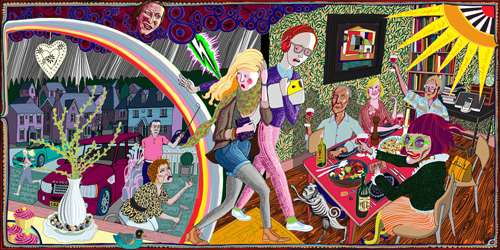


- architectonista.wordpress.com/
Grayson Perry: spinning a yarn
A show of tapestries by 14 artists making their textile debut is drawing attention to this ancient medium. Annabel Freyberg talks to Grayson Perry, who has designed one of the most provocative. Photograph by Beth Evans
'God and cuddly toys have a lot in common,' Grayson Perry opines. 'Both are imaginary characters we project our feelings on to.' Perry is talking about the alarming creature at the centre of his latest work, an 8.2ft-tall tapestry-cum-campaign banner. This is not God, but a red and raging Alan Measles, his childhood teddy (named after Alan, the boy who lived next door, and the measles Perry endured), who has appeared in a number of guises on Perry's more usual pots. Grimacing and far from cuddly, Measles wears a suicide bomber's belt, holds aloft a crudely stylised Kalashnikov and balances on the Twin Towers. 'Vote Alan Measles for God' reads the line above the 'poster' (edged in fetching red, white and blue bullets). 'He Will Save Us' avers the line at the bottom.
What is Perry up to? The work is graphically attractive, but a close inspection reveals a cache of nightmare images: bodybags, exploding planes, tanks, knives, coffins, a hooded figure Abu Ghraib-style, Osama bin Laden and other ghoulish objects associated with the War on Terror, all drawn in a cartoon style. It is like looking at the Hell section in a modern-day Garden of Earthly Delights. In fact, it is Perry's homage to a genre of carpets woven in Afghanistan since its invasion by Russia in 1979, which incorporate tanks and bombs alongside more traditional geometric motifs. Perry has been collecting these for some time. 'They're soldiers' souvenirs,' he explains. 'I lifted imagery from them and drew it in the same style - a Stanley knife, the bullets round the edge. It's a folk artefact for the age of 24-hour news; a clash between something made by hand in an age-old technique and our computer culture; a bringing together of something geographically and culturally specific and global events.'
He was mulling over what to do with this subject matter when Christopher and Suzanne Sharp asked him to design a tapestry two and a half years ago. The couple, who own and run the Rug Company, have commissioned dozens of carpets from fashion and interior designers in the past decade and wanted to get artists on board, too. They felt that tapestry might be a better medium than hand-knotted rugs, its fine weave allowing for more detail. They approached 16 artists from around the world, giving them free rein in terms of size, style and subject matter. 'We wanted the project to be really international, and we wanted people who had some connection with thread in their work,' Chris explains.
Thus alongside British favourites such as Perry, Gavin Turk, Gary Hume and Peter Blake are less familiar names such as Shahzia Sikander (Pakistani-raised and New York-based), Brazilian Beatriz Milhazes, Americans Kara Walker and Fred Tomaselli, and Egyptian-born Ghada Amer (who embroiders her paintings) in collaboration with the Iranian artist Reza Farkhondeh. Of the 16-strong wishlist, 14 responded positively, and a show of their incredibly different tapestries opens in 10 days time at the massive (70,000sq ft) old Express Dairies in Bloomsbury. There is an edition of five of each tapestry, costing from £15,000, with Perry's from £30,000; a number have already been sold.
'They're made in the same way as Renaissance tapestries,' Chris says. 'Totally handmade. You do a full-scale drawing on graph paper, then number and colour match each section. Even the bobbins are numbered - it's a bit like painting by numbers.' Though most of the Rug Company's work is produced in Nepal, for this project he selected a weaving house in China, which makes its copies of fine-weave French Aubussons. 'Because most of the artists had never done a tapestry before, we used lots of sampling,' Chris explains. One difference from the past is synthetic rather than vegetable hues, which allow a greater variety of colours and do not fade. The hardest piece to make, and the largest (14.7x15ft) was Paul Noble's monochrome drawing of a fantastical city based on an existing work. It required 40 shades of grey and took more than a year on the loom.
Grayson Perry, with his passionate interest in craft, was the one artist who decided to work in needlepoint - a coarser medium where the stitches are more noticeable. Chris remembers him saying, 'If it comes back different from the drawing then I'm happy.'
'I wanted it to look a bit ethnic,' Perry says, 'and to look as if it was designed as a tapestry rather than as a photograph that had been transposed. But in the end, what I want with everything I do is for it to look good.' He drew his tapestry by hand, half-scale, then scanned it into a computer to work on the colours. It took four or five months to weave.
One of Alan Measles' most striking attributes is the bunch-of-grapes-like shapes in his arms and legs. 'That's testosterone running through his veins - the fruits are grenades,' Perry explains. 'The whole macho thing. It's testosterone that fuels the world's problems. It relates to a dress I made many years ago with Alan Measles as an avenging angel on it. The war he wages is against bad parenting, which is the trigger for people taking their anger out on the world. Look at any dictator - Saddam Hussein was no exception - and you'll find that childhood trauma is at the root of it.'
Talk of a revival in tapestries may be premature but the medium is certainly in the spotlight once more. This autumn the leading British tapestry weavers Dovecot Studios moved into their new £8 million Edinburgh home, the old Victoria baths, while Thomas Campbell, the incoming English-born director of the Metropolitan Museum in New York, is a tapestry expert. The tapestries in this show are to be exhibited at Design Miami in December, and all manner of claims look likely to be made for them. Perry has already embarked on a new one, and as he so practically puts it, 'The best thing about a tapestry is that you can roll it up and put it in the car.'















Još keramičkih izložaka ovdje
Grayson Perry, with his passionate interest in craft, was the one artist who decided to work in needlepoint - a coarser medium where the stitches are more noticeable. Chris remembers him saying, 'If it comes back different from the drawing then I'm happy.'
'I wanted it to look a bit ethnic,' Perry says, 'and to look as if it was designed as a tapestry rather than as a photograph that had been transposed. But in the end, what I want with everything I do is for it to look good.' He drew his tapestry by hand, half-scale, then scanned it into a computer to work on the colours. It took four or five months to weave.
One of Alan Measles' most striking attributes is the bunch-of-grapes-like shapes in his arms and legs. 'That's testosterone running through his veins - the fruits are grenades,' Perry explains. 'The whole macho thing. It's testosterone that fuels the world's problems. It relates to a dress I made many years ago with Alan Measles as an avenging angel on it. The war he wages is against bad parenting, which is the trigger for people taking their anger out on the world. Look at any dictator - Saddam Hussein was no exception - and you'll find that childhood trauma is at the root of it.'
Talk of a revival in tapestries may be premature but the medium is certainly in the spotlight once more. This autumn the leading British tapestry weavers Dovecot Studios moved into their new £8 million Edinburgh home, the old Victoria baths, while Thomas Campbell, the incoming English-born director of the Metropolitan Museum in New York, is a tapestry expert. The tapestries in this show are to be exhibited at Design Miami in December, and all manner of claims look likely to be made for them. Perry has already embarked on a new one, and as he so practically puts it, 'The best thing about a tapestry is that you can roll it up and put it in the car.'















Još keramičkih izložaka ovdje
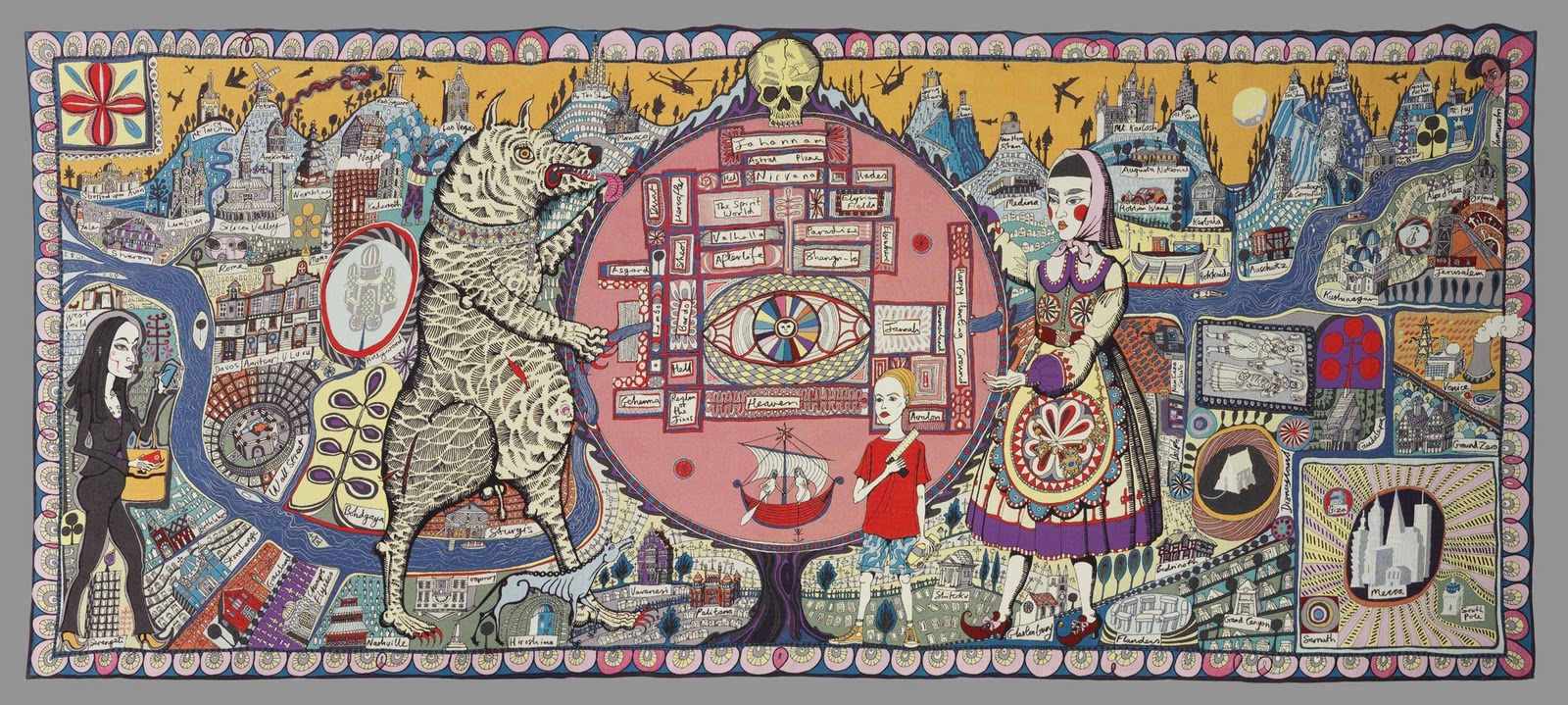
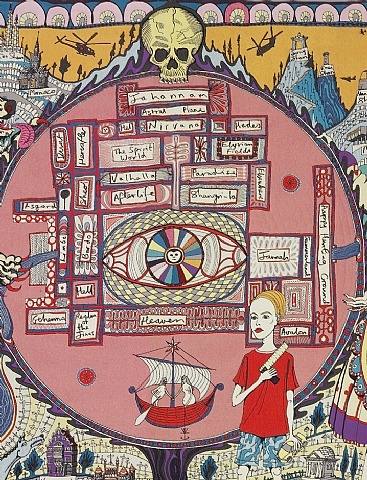








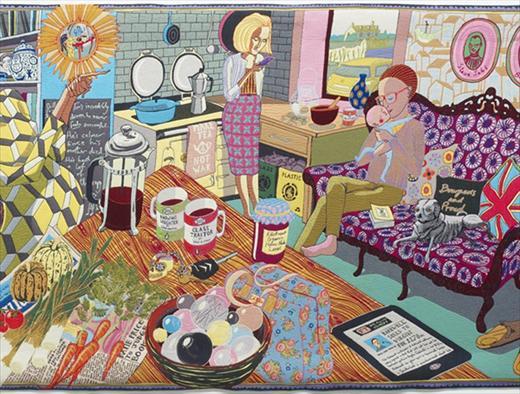


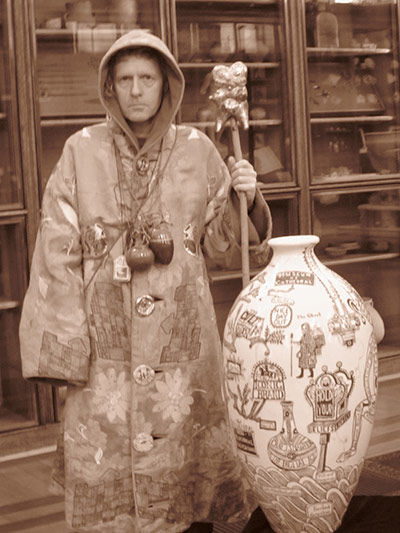










![Grayson Perry: Portrait of The Artist As a Young Girl [Paperback]](http://ecx.images-amazon.com/images/I/51jaoD2yvOL._SL500_AA300_.jpg)